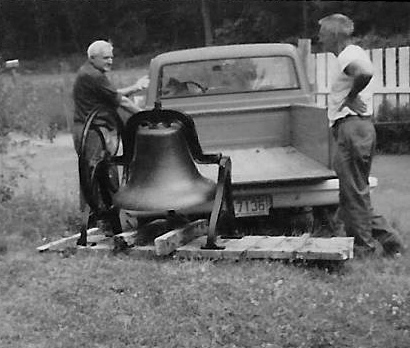Officer Polak and the Cruiser 1942

Officer “Andy” Polak and the Cruiser 1942
Webster Street looking North C 1920

Webster St North from Ferry St C 1920
This brings us to this week’s photo of Webster Street, looking north, just after the intersection with Ferry Street C 1920. Along the left of Webster Street are the tracks of the trolley which went north to Manchester. Think of the sharp turn the trolley car(s) made after leaving the bridge, stopping at the transfer station to leave and/or pick up passengers, then making the turn onto Webster street and heading north.
The small building on the left is the grainery which history tells us was also used as the local jail. You may ask what became of the jail? According to the Town Report for the year ending 1918 the town paid Law and Ingham $13.00 to move a safe and cells. Did not state where they were moved from or to. Also, a brief article in the February 19, 1918 edition of the Nashua Telegraph tells us that a young man named Roland Abbott had plans to repair and remodel the building and use it as a club house for the young people of Hudson. It is doubtful that this club house ever became a reality. We do know the building was later moved to Ferry Street, placed on a foundation and used as part of the dwelling at what is now 88 Ferry Street. At the time of this move the property was owned by Nathen Cummings. Some residents of today may remember it as the home of Clayton and Victoria Smith. Photo from the Historical Society Collection.
Hudson Center School Bell

School Bell at Hills House

Charlie and Eric Parker Transporting Bell
Aerial View Fulton and Reed Streets C 1955

Aerial View Fulton, Reed, Central Streets C 1955
If you live in the vicinity of Maple Avenue, Reed, Fulton, and Central Street you may well be able to locate your home on this C 1955 aerial photograph. Based upon our accession records at the Historical Society this photo was taken C 1955 from an aircraft owned by Sanders Associates (now BAE Systems of Nashua). The lack of foliage on the trees during the winter months increased the visibility of the buildings from the air. The aircraft was flying in a south easterly direction over this area.
If we look to the left of center the easiest building to locate is the American Legion building at the corner of Central and Fulton Streets at 37 Central. Opposite Fulton at Central is the beginning of Chase Street. We can see the homes from 43 Central westerly toward Maple Avenue and the bridge; including homes to 16 Central Street. The Hudson Community Church (Brick Church) is not shown but you can see the shadow of the church building on Central Street and the home opposite the church. At the time of this photo this home was known as the Dudley/Emerson House; home of Deputy Harry Emerson; a 50 year member of the Hudson Fire Department. In the late 1960’s this home and other homes in the area of Central and Ferry Streets were razed in order to improve access to and egress from the Veteran’s Memorial and New Taylor Falls Bridges. This lot remained empty until 2016 at which time the property was sold and a duplex house is now being built on this site.
Between 27 and 25 Central we see Maple Avenue going southerly past the intersection with Reed Street on the left and on toward what is now Merrill Park on the right and near the edge of the Merrimack River. At the end of Maple Avenue is the remains of the right of way for the steam railroad used by residents to make a connection with the southern end of Fulton Street. Another easy to identify landmark is at the corner of Maple and Reed Street. This house is the former Merrill Family Home. Known to many as the home of Marjorie and Natalie Merrill and a previous site of Hudson’s Town Library.
Returning on Fulton Street towards Central we see most of Reed Street running parallel with Central and extending towards Gillis Street on the upper left of the photo. As we move away from the bridge area we can identify a number of undeveloped lots and open space beyond Gillis and Reed Streets.
One final street to locate is the beginning of School Street just at the intersection with Cummings Street as shown on the lower left in the photo. Easily identified are the homes of Paul and Hazel Buxton and their family on School Street; and the former home of Dr. William Quigley and his family facing the intersection with Cummings Street. The Buxton Family has (and is) serving the town in a number of areas; including Fire Department, Historical Society, and Hills Memorial Library. Dr. Quigley provided medical services to Hudson and Hudson Schools. This photo is from the collection at the Historical Society.